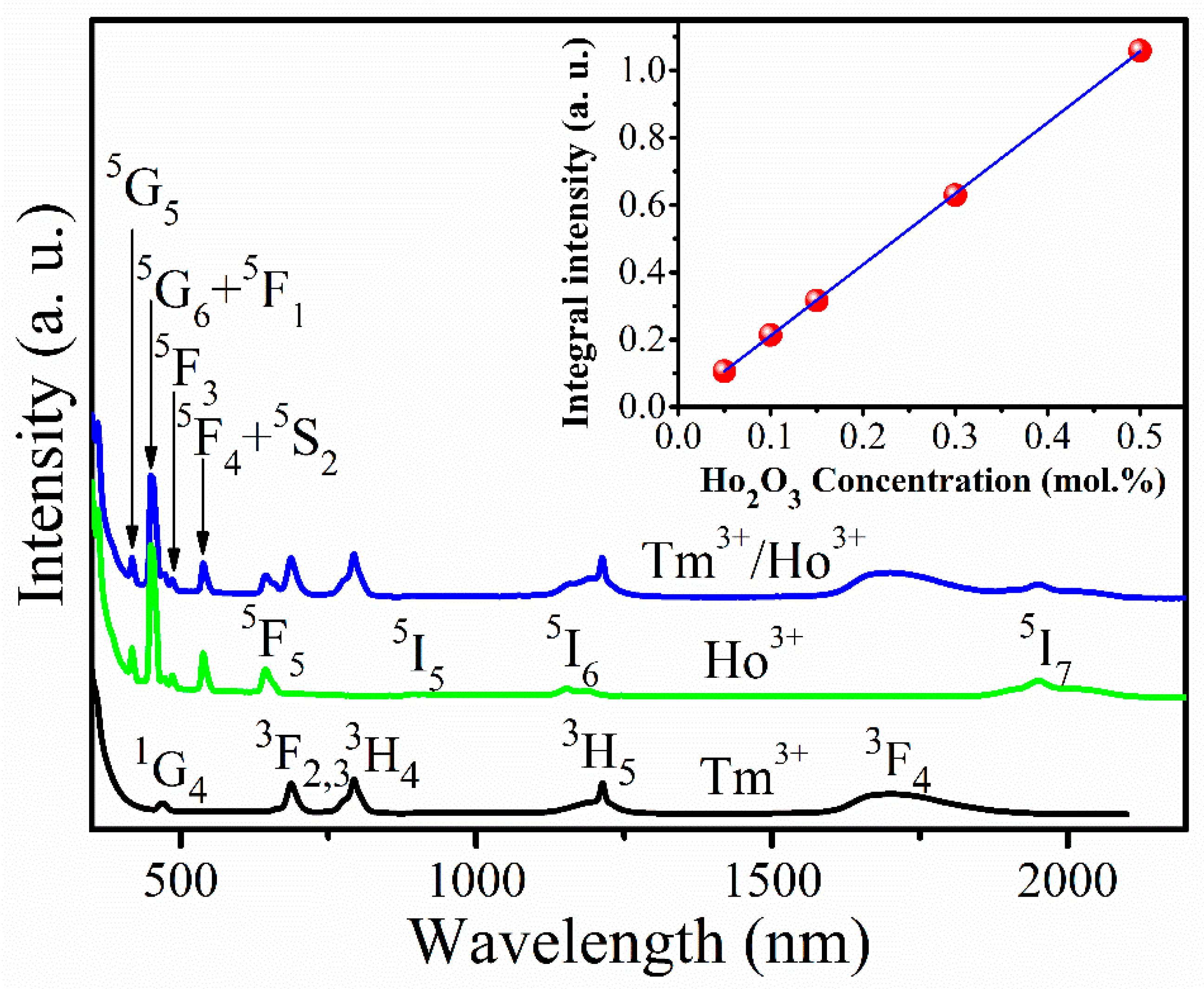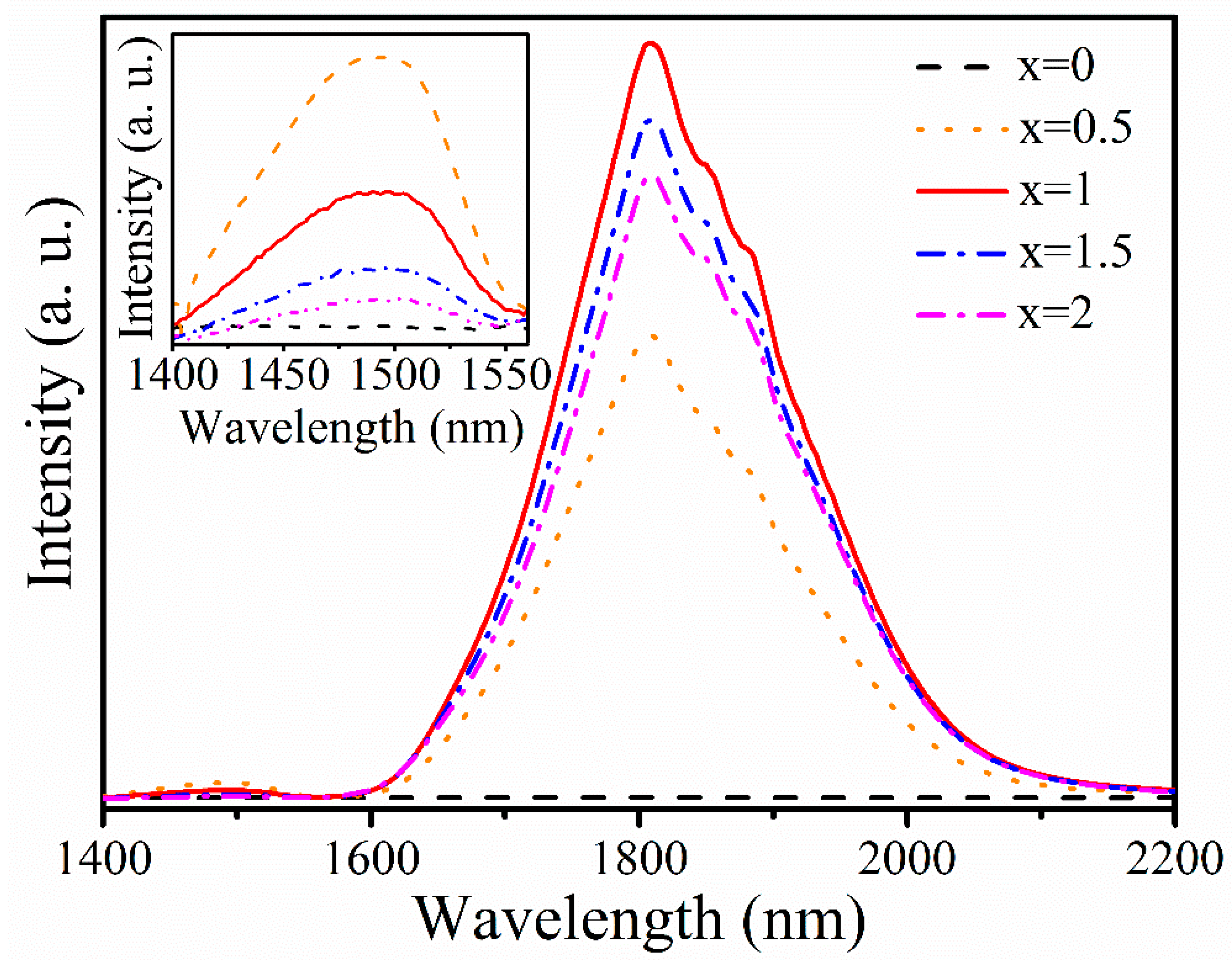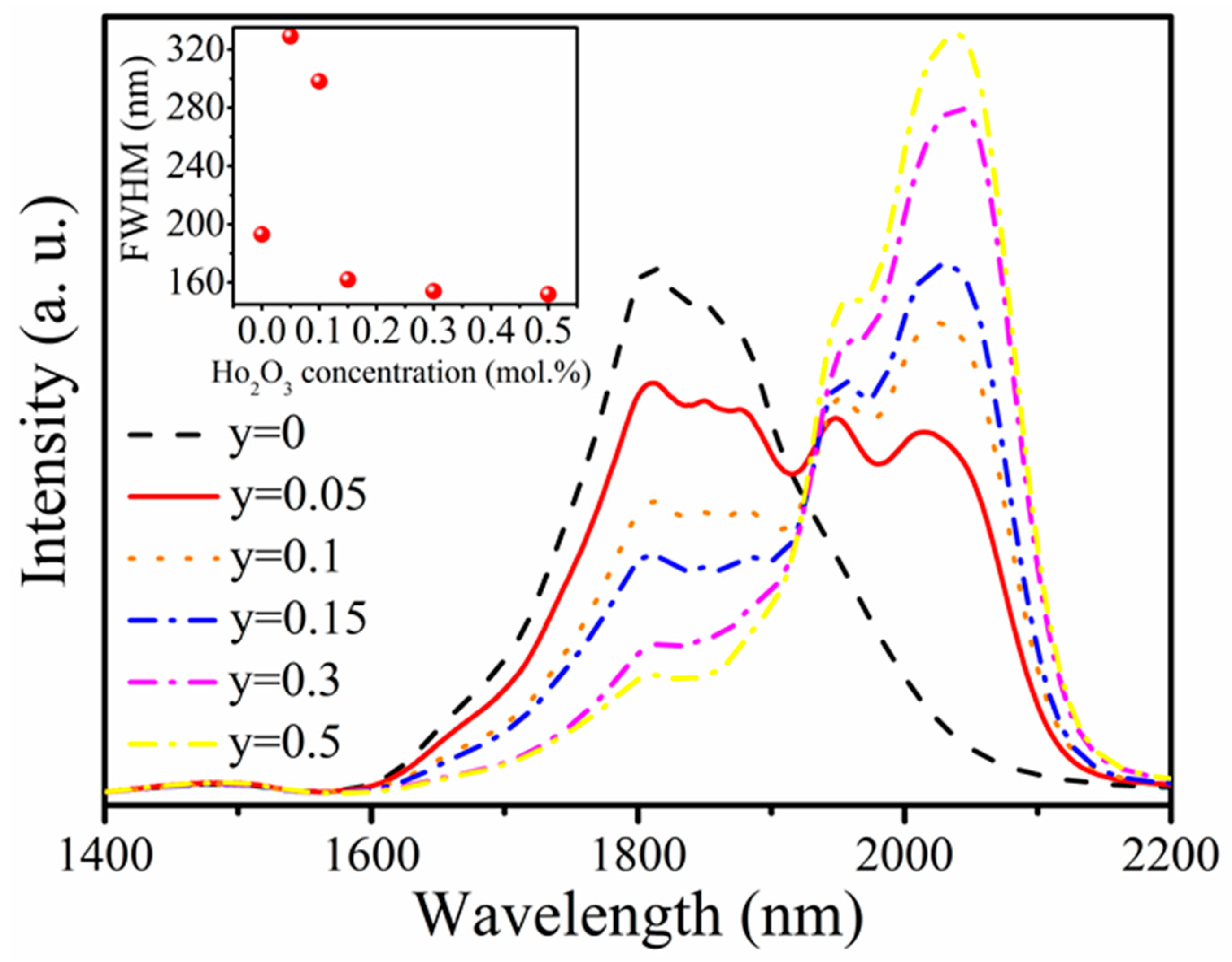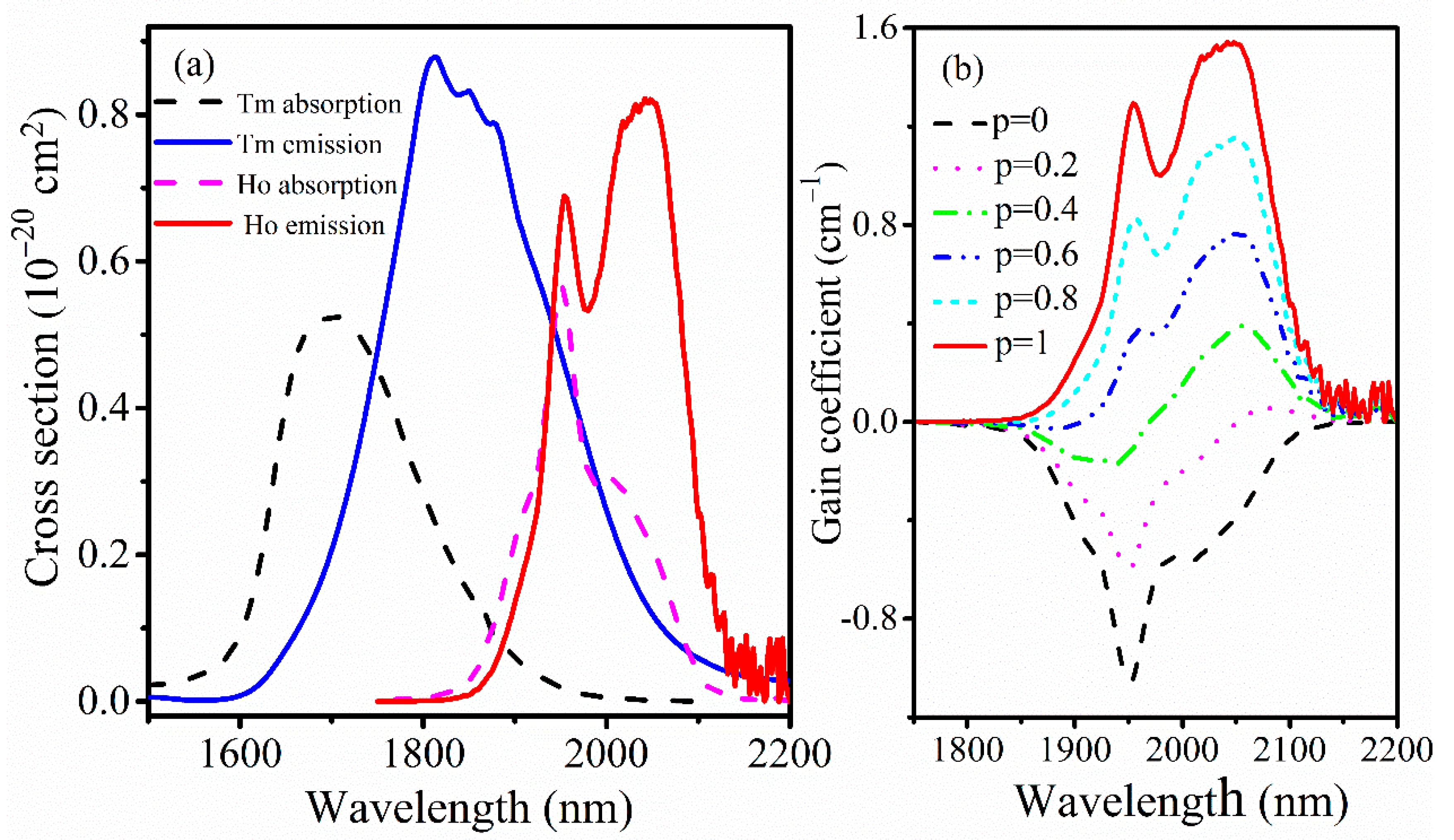2.0 μm Ultra Broadband Emission from Tm3+/Ho3+ Co-Doped Gallium Tellurite Glasses for Broadband Light Sources and Tunable Fiber Lasers
Abstract
1. Introduction
2. Materials and Methods
3. Results and Discussion
3.1. Absorption Spectra
3.2. Fluorescence Spectra and Energy Transfer Mechanism
3.3. Gain Properties and Energy Transfer Coefficients between Tm3+ and Ho3+ Ions
4. Conclusions
Author Contributions
Funding
Conflicts of Interest
References
- Jackson, S.D. Towards high-power mid-infrared emission from a fibre laser. Nat. Photonics 2012, 6, 423–431. [Google Scholar] [CrossRef]
- Tsang, Y.H.; King, T.A.; Ko, D.K.; Lee, J.M. Broadband amplified spontaneous emission double-clad fibre source with central wavelengths near 2 μm. J. Mod. Opt. 2006, 53, 991–1001. [Google Scholar] [CrossRef]
- Wang, W.C.; Zhou, B.; Xu, S.H.; Yang, Z.M.; Zhang, Q.Y. Recent advances in soft optical glass fiber and fiber lasers. Prog. Mater. Sci. 2019, 101, 90–171. [Google Scholar] [CrossRef]
- Kochanowicz, M.; Zmojda, J.; Miluski, P.; Baranowska, A.; Leich, M.; Schwuchow, A.; Jaeger, M.; Kuwik, M.; Pisarska, J.; Pisarski, W.A.; et al. Tm3+/Ho3+ co-doped germanate glass and double-clad optical fiber for broadband emission and lasing above 2 μm. Opt. Mater. Express 2019, 9, 1450–1458. [Google Scholar] [CrossRef]
- Wang, Z.H.; Zhang, B.; Liu, J.; Song, Y.F.; Zhang, H. Recent developments in mid-infrared fiber lasers: Status and challenges. Opt. Laser Technol. 2020, 132, 106497. [Google Scholar] [CrossRef]
- Yin, T.C.; Mao, B.M.; Wei, Y.Z.; Chen, D.R. Widely wavelength-tunable 2 μm Brillouin fiber laser incorporating a highly germania-doped fiber. Appl. Opt. 2018, 57, 6831–6834. [Google Scholar] [CrossRef]
- Wang, W.C.; Zhang, W.J.; Li, L.X.; Liu, Y.; Zhang, Q.Y. Spectroscopic and structural characterization of barium tellurite glass fibers for mid-infrared ultra-broad tunable fiber lasers. Opt. Mater. Express 2016, 6, 2095–2107. [Google Scholar] [CrossRef]
- Richards, B.; Jha, A.; Tsang, Y.; Binks, D.; Lousteau, J.; Fusari, F.; Lagatsky, A.; Brown, C.; Sibbett, W. Tellurite glass lasers operating close to 2 μm. Laser Phys. Lett. 2010, 7, 177–193. [Google Scholar] [CrossRef]
- Kim, J.W.; Mackenzie, J.I.; Parisi, D.; Veronesi, S.; Tonelli, M.; Clarkson, W.A. Efficient in-band pumped Ho: LuLiF4 2 μm laser. Opt. Lett. 2010, 35, 420–422. [Google Scholar] [CrossRef] [PubMed]
- Eichhorn, M.; Jackson, S.D. High-pulse-energy, actively Q-switched Tm3+, Ho3+-codoped silica 2 μm fiber laser. Opt. Lett. 2008, 33, 1044–1046. [Google Scholar] [CrossRef]
- Gao, G.J.; Hu, L.L.; Fan, H.Y.; Wang, G.N.; Li, K.F.; Feng, S.Y.; Fan, S.J.; Chen, H.Y.; Pan, J.J.; Zhang, J.J. Investigation of 2.0 μm emission in Tm3+ and Ho3+ co-doped TeO2-ZnO-Bi2O3 glasses. Opt. Mater. 2009, 32, 402–405. [Google Scholar] [CrossRef]
- Li, K.F.; Zhang, G.; Wang, X.; Hu, L.L.; Kuan, P.W.; Chen, D.P.; Wang, M. Tm3+ and Tm3+-Ho3+ co-doped tungsten tellurite glass single mode fiber laser. Opt. Express 2012, 20, 10115–10121. [Google Scholar] [CrossRef] [PubMed]
- Xue, G.H.; Zhang, B.; Yin, K.; Yang, W.Q.; Hou, J. Ultra-wideband all-fiber tunable Tm/Ho-co-doped laser at 2 μm. Opt. Express 2014, 22, 25976–25983. [Google Scholar] [CrossRef]
- Richards, B.; Shen, S.X.; Jha, A.; Tsang, Y.; Binks, D. Infrared emission and energy transfer in Tm3+, Tm3+-Ho3+ and Tm3+-Yb3+-doped tellurite fibre. Opt. Express 2007, 15, 6546–6551. [Google Scholar] [CrossRef] [PubMed]
- Jha, A.; Shen, S.; Naftaly, M. Structural origin of spectral broadening of 1.5-μm emission in Er3+-doped tellurite glasses. Phys. Rev. B 2000, 62, 6215–6227. [Google Scholar] [CrossRef]
- Li, L.X.; Wang, W.C.; Zhang, C.F.; Liu, J.L.; Zhang, Q.Y.; Jiang, Z.H. Exploration of the new tellurite glass system for efficient 2 μm luminescence. J. Non Cryst. Solids 2019, 508, 15–20. [Google Scholar] [CrossRef]
- Mao, L.Y.; Liu, J.L.; Li, L.X.; Wang, W.C. TeO2-Ga2O3-ZnO ternary tellurite glass doped with Tm3+ and Ho3+ for 2 μm fiber lasers. J. Non Cryst. Solids 2020, 531, 119855. [Google Scholar] [CrossRef]
- Yuan, J.; Wang, W.C.; Ye, Y.C.; Deng, T.T.; Ou, D.Q.; Cheng, J.Y.; Yuan, S.J.; Xiao, P. Effect of BaF2 variation on spectroscopic properties of Tm3+ doped gallium tellurite glasses for efficient 2.0 μm laser. Front. Chem. 2021, 8, 628273. [Google Scholar] [CrossRef]
- Zhou, M.H.; Zhou, Y.X.; Su, X.E.; Zhu, Y.R.; Zhou, Z.Z.; Cheng, P. Around 2 μm fluorescence and energy transfer in Tm3+/Ho3+ co-doped tellurite glass. J. Non Cryst. Solids 2018, 481, 344–351. [Google Scholar] [CrossRef]
- Gao, X.Y.; Tian, Y.; Liu, Q.H.; Li, B.P.; Tang, W.H.; Zhang, J.J.; Xu, S.Q. Broadband 2 μm emission characteristics and energy transfer mechanism of Ho3+ doped silicate-germanate glass sensitized by Tm3+ ions. Opt. Laser Technol. 2019, 111, 115–120. [Google Scholar] [CrossRef]
- Balda, R.; Lacha, L.M.; Fernandez, J.; Fernandez-Navarro, J.M. Optical spectroscopy of Tm3+ ions in GeO2-PbO-Nb2O5 glasses. Opt. Mater. 2005, 27, 1771–1775. [Google Scholar] [CrossRef]
- Lin, H.; Wang, X.Y.; Li, C.M.; Yang, H.X.; Pun, E.Y.B.; Tanable, S. Near-infrared emissions and quantum efficiencies in Tm3+-doped heavy metal gallate glasses for S- and U-band amplifiers and 1.8 μm infrared laser. J. Lumin. 2008, 128, 74–80. [Google Scholar] [CrossRef]
- Gebavi, H.; Taccheo, S.; Milanese, D. The enhanced two micron emission in thulium doped tellurite glasses. Opt. Mater. 2013, 35, 1792–1796. [Google Scholar] [CrossRef]
- Cao, R.J.; Lu, Y.; Tian, Y.; Huang, F.F.; Xu, S.Q.; Zhang, J.J. Spectroscopy of thulium and holmium co-doped silicate glasses. Opt. Mater. Express 2016, 6, 2252–2263. [Google Scholar] [CrossRef]
- Kochanowicz, M.; Zmojda, J.; Miluski, P.; Baranowska, A.; Ragin, T.; Dorosz, J.; Kuwik, M.; Pisarski, W.A.; Pisarska, J.; Lesniak, M.; et al. 2 μm emission in gallo-germanate glasses and glass fibers co-doped with Yb3+/Ho3+ and Yb3+/Tm3+/Ho3+. J. Lumin. 2019, 211, 341–346. [Google Scholar] [CrossRef]
- Wang, C.Z.; Tian, Y.; Gao, X.Y.; Liu, Q.H.; Huang, F.F.; Li, B.P.; Zhang, J.J.; Xu, S.Q. Mid-infrared fluorescence properties, structure and energy transfer around 2 μm in Tm3+/Ho3+ co-doped tellurite glass. J. Lumin. 2018, 194, 791–796. [Google Scholar] [CrossRef]
- McCumber, D.E. Einstein relations connecting broadband emission and absorption spectra. Phys. Rev. 1964, 136, A954–A957. [Google Scholar] [CrossRef]
- Yang, X.L.; Wang, W.C.; Zhang, Q.Y. BaF2 modified Cr3+/Ho3+ co-doped germanate glass for efficient 2.0 μm fiber lasers. J. Non Cryst. Solids 2018, 482, 147–153. [Google Scholar] [CrossRef]
- Wang, N.; Cao, R.J.; Cai, M.Z.; Lu, Y.; Shen, L.L.; Tian, Y.; Huang, F.F.; Xu, S.Q.; Zhang, J.J. An efficient 2.0 μm emission of Er3+/Ho3+ co-doped lead silicate glass. Infrared Phys. Technol. 2017, 83, 1–6. [Google Scholar] [CrossRef]
- Chen, R.; Tian, Y.; Li, B.P.; Jing, X.F.; Zhang, J.J.; Xu, S.Q.; Eckert, H.; Zhang, X.H. Thermal and luminescent properties of 2 μm emission in thulium-sensitized holmium-doped silicate-germanate glass. Photon. Res. 2016, 4, 214–221. [Google Scholar] [CrossRef]
- Zou, X.L.; Toratani, H. Spectroscopic properties and energy transfers in Tm3+ singly- and Tm3+/Ho3+ doubly-doped glasses. J. Non. Cryst. Solids 1996, 195, 113–124. [Google Scholar] [CrossRef]
- Zhu, T.T.; Tang, G.W.; Chen, X.D.; Sun, M.; Qian, Q.; Chen, D.D.; Yang, Z.M. Two micrometer fluorescence emission and energy transfer in Yb3+/Ho3+ co-doped lead silicate glass. Int. J. Appl. Glass Sci. 2017, 8, 196–203. [Google Scholar] [CrossRef]
- Shen, L.L.; Cai, M.Z.; Lu, Y.; Wang, N.; Huang, F.F.; Xu, S.Q.; Zhang, J.J. Preparation and investigation of Tm3+/Ho3+ co-doped germanate-tellurite glass as promising materials for ultrashort pulse laser. Opt. Mater. 2017, 67, 125–131. [Google Scholar] [CrossRef]
- Miyakawa, T.; Dexter, D.L. Phonon Sidebands, Multiphonon Relaxation of Excited States, and Phonon-Assisted Energy Transfer between Ions in Solids. Phys. Rev. B 1970, 1, 2961–2969. [Google Scholar] [CrossRef]
- Tarelho, L.V.G.; Gomes, L.; Ranieri, I.M. Determination of microscopic parameters for nonresonant energy-transfer processes in rare-earth-doped crystals. Phys. Rev. B 1997, 56, 14344–14351. [Google Scholar] [CrossRef]







| Energy Transfer | N( Number of Phonons) (% Phonon Assisted) | Energy Transfer Coefficient (cm6/s) | |
|---|---|---|---|
| Tm3+ → Tm3+(migration) (3F4 + 3H6 → 3H6 + 3F4) | 0 | 1 | 8.98 × 10−39 |
| 99.86 | 0.16 | ||
| Tm3+ → Ho3+ (direct transfer) (3F4 → 5I7) | 0 | 1 | 6.22 × 10−39 |
| 94.95 | 5.05 | ||
| Ho3+ → Tm3+ (back transfer) (5I7 → 3F4) | 0 | 1 | 3.16 × 10−40 |
| 99.32 | 0.68 | ||
Publisher’s Note: MDPI stays neutral with regard to jurisdictional claims in published maps and institutional affiliations. |
© 2021 by the authors. Licensee MDPI, Basel, Switzerland. This article is an open access article distributed under the terms and conditions of the Creative Commons Attribution (CC BY) license (http://creativecommons.org/licenses/by/4.0/).
Share and Cite
Yuan, J.; Wang, W.; Ye, Y.; Deng, T.; Huang, Y.; Gu, S.; Chen, Y.; Xiao, P. 2.0 μm Ultra Broadband Emission from Tm3+/Ho3+ Co-Doped Gallium Tellurite Glasses for Broadband Light Sources and Tunable Fiber Lasers. Crystals 2021, 11, 190. https://doi.org/10.3390/cryst11020190
Yuan J, Wang W, Ye Y, Deng T, Huang Y, Gu S, Chen Y, Xiao P. 2.0 μm Ultra Broadband Emission from Tm3+/Ho3+ Co-Doped Gallium Tellurite Glasses for Broadband Light Sources and Tunable Fiber Lasers. Crystals. 2021; 11(2):190. https://doi.org/10.3390/cryst11020190
Chicago/Turabian StyleYuan, Jian, Weichao Wang, Yichen Ye, Tingting Deng, Yizhao Huang, Shitao Gu, Yuanbin Chen, and Peng Xiao. 2021. "2.0 μm Ultra Broadband Emission from Tm3+/Ho3+ Co-Doped Gallium Tellurite Glasses for Broadband Light Sources and Tunable Fiber Lasers" Crystals 11, no. 2: 190. https://doi.org/10.3390/cryst11020190
APA StyleYuan, J., Wang, W., Ye, Y., Deng, T., Huang, Y., Gu, S., Chen, Y., & Xiao, P. (2021). 2.0 μm Ultra Broadband Emission from Tm3+/Ho3+ Co-Doped Gallium Tellurite Glasses for Broadband Light Sources and Tunable Fiber Lasers. Crystals, 11(2), 190. https://doi.org/10.3390/cryst11020190






